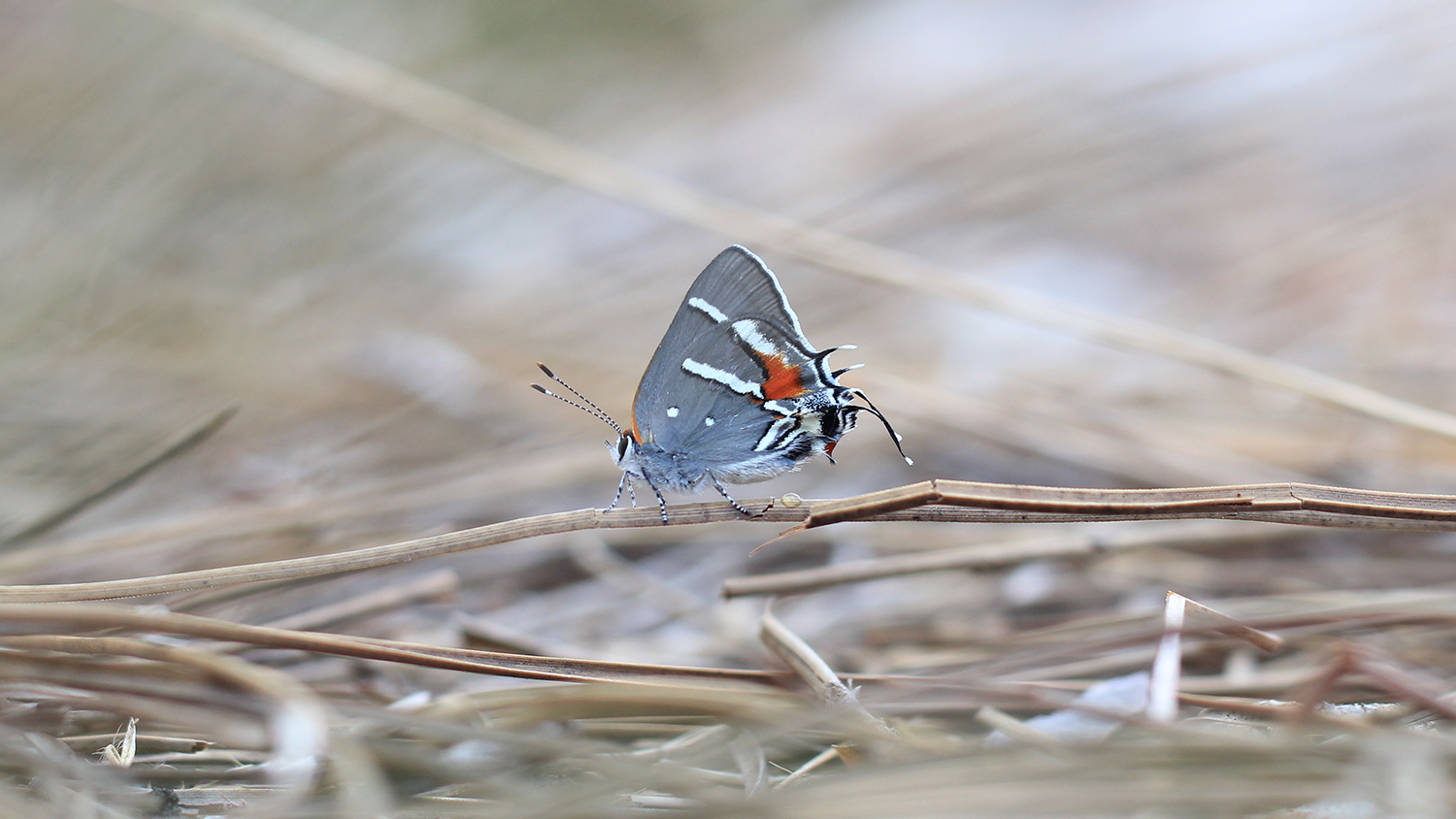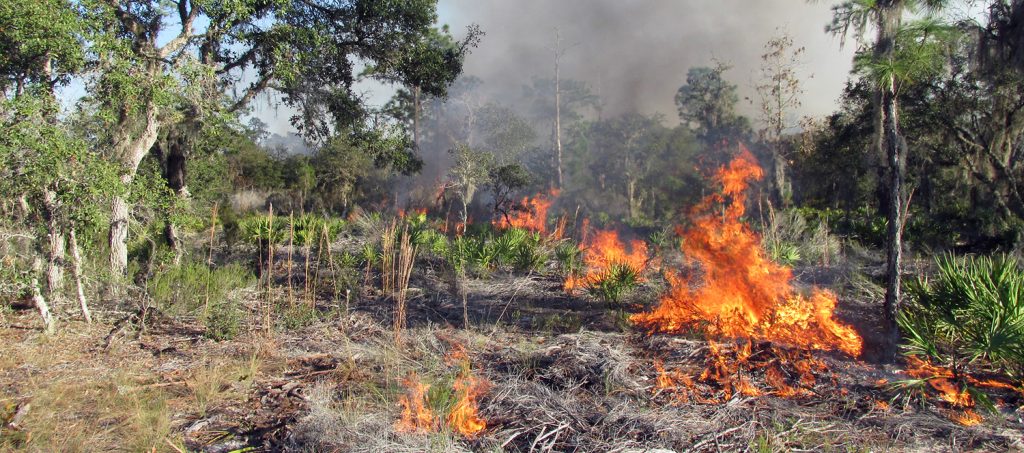Fire and Butterflies: Insights From a Natural Disaster

Editor’s Note: This is a guest post by Erica Henry, a postdoctoral researcher in NC State’s Department of Biological Sciences. This post is part of a series highlighting ways that NC State is helping us understand, mitigate and prepare for the impacts of climate change.
I’ve always known, in an abstract way, that the possibility exists I may see a species go extinct. Late in the summer of 2017, it looked like that possibility might become a reality.
The butterflies I study are precariously close to extinction. Miami blues (Cyclargus thomasi bethunebakeri) once flourished along Florida’s beach berms, and Bartram’s scrub-hairstreaks (Strymon acis bartrami) flitted about in pine rockland forests along the Miami rock ridge, which underlies much of southeast Florida. Now, nearly all of the habitat for both of these butterflies has disappeared under the city of Miami. Miami blues are left on a handful of islands 25 miles west of Key West, beyond the sunset view. Bartram’s scrub-hairstreaks are slightly better off. Before Hurricane Irma, populations of these grey and white butterflies – with their distinctive orange spots – could be found on Big Pine Key, in Everglades National Park and in a few undeveloped forest patches in Miami-Dade County.
When Hurricane Irma hit the lower Florida Keys, I was in Raleigh, finalizing analyses and writing dissertation chapters. I had been working in the Keys for six years, conducting research related to butterfly conservation. I had figured out how many Miami blues exist on the planet (answer: tens of thousands), and had conducted an experiment to test how to best restore pine rockland habitat for Bartram’s scrub-hairstreaks (answer: burn it). On Tuesday, Sept. 5, 2017 Hurricane Irma was a Category 5 hurricane — and all of the butterflies and all of my research were in the center of the 8 a.m. National Hurricane Center cone.

Hurricanes and Extinction
Major hurricanes are not a new threat to these species. But the context within which hurricanes strike is.
Not only is the landscape shifting under these butterflies, but the climate is as well. As carbon dioxide increases in the atmosphere and the climate warms, hurricanes get bigger and the probability of a storm becoming a major hurricane increases. This raises the question: what can we do to prevent hurricane-driven extinction for species like Miami blues and Bartram’s scrub-hairstreaks already teetering on the edge? This was not the question I set out to answer when I started working in the Keys eight years ago, but Hurricane Irma changed that.
Prior to the hurricane, the Bartram’s scrub-hairstreak population on Big Pine Key was in trouble. As caterpillars, these butterflies dine on pineland croton, an evergreen shrub that thrives in pine rockland forests that burn every 3-7 years. Without fire, species that rely on the cycle of burning and regrowth go extinct. And the loss of frequent fires on Big Pine Key meant that its populations of plants and butterflies – like croton and Bartram’s – were in a steep decline.
The Catch-22 of Forest Fires
The reason pine rockland forests on Big Pine hadn’t burned for over a decade is people. It’s easy to light fires in open spaces with very few neighbors, like in the middle of Everglades National Park. But it is nearly impossible to burn a forest surrounded by houses.
The catch, however, is that the longer these forests go without fire, the more dangerous the eventual wildfire becomes – and the more likely it is to threaten houses and other important infrastructure. This is a problem that plagues fire management across ecosystems. And climate change is making it even more difficult to manage fire in landscapes that have evolved to rely on that fire. Warmer temperatures and shortened rainy seasons in the Florida Keys means that the vegetation stays dry months into the summer. Dry vegetation combined with reduced precipitation and increased summer breezes makes it difficult to find a window in which the conditions are just right to light a fire. So the forest goes unburned another year. And gets more overgrown. And the eventual wildfire – which is inevitable – becomes more dangerous.

Figuring out how to best manage these forests so that butterflies and people can coexist on Big Pine Key was at the top of the list of questions I wanted to answer as part of my dissertation.
I wanted to know whether we could use mechanical understory removal methods (i.e., using heavy equipment to mulch the plants that grow under trees) as a surrogate for fire, and how that might benefit croton plants and Bartram’s scrub-hairstreaks. So I designed an experiment. We mechanically cleared plots, we planned on burning plots, and we left plots alone as untreated controls. Prior to the experiment, I tagged and counted plants and surveyed for adult butterflies and caterpillars. The weather didn’t cooperate, and my fire plots never burned. But I went back after mechanical clearing, re-measured tagged plants, and tagged new ones that had emerged. I re-surveyed for butterflies and caterpillars. And then Irma hit it all.
An Opportunity in the Devastation
Irma roared across the Florida Keys as a Category 4 hurricane on Sept. 10, 2017. She made landfall on Cudjoe Key, 10 miles west of Big Pine Key. This put Big Pine Key, and my experiment, in the eastern eyewall of the storm, the most brutal part of a hurricane, with the highest winds and greatest storm surge. Big Pine Key was entirely overwashed with ocean water and the strongest wind gusts were estimated at 160 miles per hour. Trees were snapped in half, whole houses were washed out to sea, and debris blanketed the island. It was devastating.
But it was also an opportunity.
Because I had previously set up a habitat management experiment, I was perfectly poised to now look at how the management we had done prior to the storm interacted with the effects of the hurricane. So I went back nine months after Irma, re-measured tagged plants, and re-surveyed for butterflies and caterpillars.
Hurricane Irma was bad for croton on Big Pine Key. On average, only 30-40% of the tagged croton plants survived. However, in plots that had been mechanically cleared prior to the storm, survival rates were higher than plots that were not treated. If this pattern continues to hold as croton populations recover from the storm, it will be a clear sign that doing the background management is necessary to maintain populations of rare species threatened by increasing probability of catastrophic hurricanes.
In other words, the findings suggest that human intervention can help to mitigate some effects of climate change when it comes to preserving threatened habitats. Maybe interventions like ours could also address wildfire concerns related to postponing prescribed burns – though that’s a question for other researchers to answer.
But it’s important that we help preserve threatened habitats before it’s too late.
Bad News, Good News
Irma was the last straw for Bartram’s scrub-hairstreaks on Big Pine Key. We have not seen an adult or a caterpillar since the storm. Luckily, the species is not extinct. Other populations exist on the mainland, in places that burn on a regular basis. While the hurricane was the ultimate cause of the butterfly’s extinction on the island, lack of fire management prior to the storm was really the cause. I measured that prior to Irma the croton population was declining at a rate of 20% per year, and the butterflies were disappearing just as fast. Had the habitat been in better shape prior to the storm, I have no doubt that there would still be Bartram’s scrub-hairstreaks on that island.
I remain optimistic, because I know there are actions we can take to prevent extinction.
That Hurricane Irma caused local extinction of a Bartram’s scrub-hairstreak population is a cautionary tale for Miami blues and other vulnerable species. Had the storm tracked just 40 miles further west, there might not be Miami blues left for me to write about today.
People often ask me if my work is depressing, constantly thinking about species that are so close to extinction. It can be. But I remain optimistic, because I know there are actions we can take to prevent extinction – and I know many species are capable of rapid adaptive change.
My research shows that maintaining historic fire regimes in fire-adapted habitats – or finding functional alternatives to those fire regimes — has the potential to increase a species’ ability to absorb the gut punch that is a major hurricane. This has the added benefit of increasing the safety of homes adjacent to fire-prone forests. We can also preserve and manage places where rare species currently exist and thrive, so that they don’t end up like Miami blues, defenseless on a small handful of islands.
Climate change isn’t making any of this easy, and will likely put more species in the position of the butterflies that I study. But if we maintain large populations in as many places as possible we at least give them a chance to surprise us.
This post was originally published in NC State News.